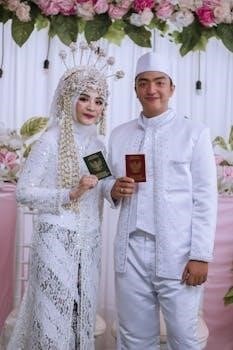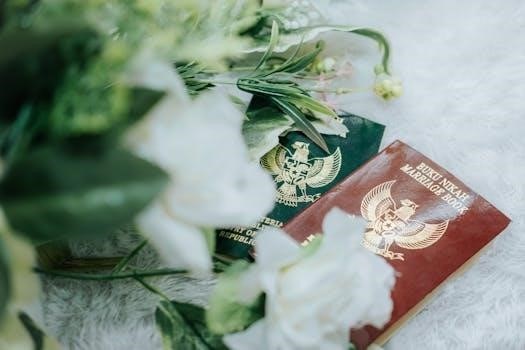
Overview of Municipal Form No. 97
Municipal Form No. 97, specifically the revised August 2016 version, serves as the official Certificate of Marriage in the Philippines. This document records key details of a marriage, and is essential for legal recognition.
Purpose of the Certificate of Marriage
The primary purpose of the Certificate of Marriage, specifically Municipal Form No. 97, revised in August 2016, is to provide official documentation of a legally recognized marriage within the Philippines. This form serves as conclusive evidence that a marriage ceremony has been performed and that the union is legally registered. It is used for various legal and administrative purposes, such as updating civil records, establishing spousal rights, and proving marital status for immigration, insurance, and other legal proceedings. The certificate also facilitates the recording of the marriage in the Local Civil Registry Office, ensuring its place in the national civil registry. It is a crucial document for both individuals and the state, confirming their new status and responsibilities under the law. Furthermore, it allows for the tracking of vital statistics related to marriage within the country, contributing to demographic data analysis.
Issuing Authority and Date
The Municipal Form No. 97, specifically the revised version from August 2016, is issued by the Office of the Civil Registrar General in the Philippines. This office is the central authority responsible for overseeing the registration of vital events, including marriages. The form is typically filled out and issued by the local civil registrar or the solemnizing officer immediately following the marriage ceremony. The date of issuance is critical, as it signifies the official registration date of the marriage. The August 2016 revision indicates a specific update to the form, which means older versions may not be considered valid for official purposes. It is crucial that the certificate reflects the correct date to ensure accurate record-keeping and legal validity. The date also serves as an important reference point for any legal procedures or applications requiring proof of marriage. The form is completed in quadruplicate using black ink, further ensuring uniformity and legibility.

Details Within the Form
The form includes detailed information about the contracting parties, marriage license details, and signatures for validation. This ensures all relevant data is captured for official records and legal purposes.
Information on Contracting Parties
This section of Municipal Form No. 97 requires comprehensive details about both the husband and wife. It includes their full names, encompassing first, middle, and last names to ensure accurate identification. Furthermore, the form mandates the inclusion of their respective dates of birth, clarifying their age at the time of marriage. The form also specifies the need to record their places of birth, as well as their respective citizenships, further establishing their identities. This section is crucial for accurately documenting the individuals entering into the marriage, providing a clear record for future reference and legal matters. This data ensures a comprehensive profile of each spouse.
Marriage License and Application Details
This section of Municipal Form No. 97 is dedicated to documenting the specifics of the marriage license and its associated application. It includes the crucial details of the marriage license, such as the license number, which is essential for verifying the legality of the union. The form also incorporates information about the application for the marriage license, including the application number and the date when it was filed. These details are vital in creating an audit trail, making sure that all necessary legal steps were followed before the marriage took place; This section verifies the lawful process of obtaining permission to marry, thereby ensuring the validity of the marriage.
Signatures and Validation
The section on signatures and validation within Municipal Form No. 97 is crucial for confirming the authenticity of the marriage certificate. This part requires the signatures of the contracting parties, the solemnizing officer who officiated the marriage, and the witnesses present during the ceremony. These signatures act as legal attestations to the marriage, verifying that the union was conducted according to the law. Additionally, this area may include official stamps or seals from the issuing authority, further enhancing the document’s credibility. These elements collectively serve as validation, which confirms the marriage’s official status and ensures it is recognized by legal authorities.

Form Usage and Process
The correct usage of Municipal Form No. 97 involves specific procedures for filing and registration. This ensures that the marriage is officially recorded with the local authorities.
Filing and Registration Procedures
The filing and registration process for Municipal Form No. 97, the Certificate of Marriage, is crucial for legal recognition. After the marriage ceremony, the completed form, with attached marriage license and application, must be submitted to the Local Civil Registry Office (LCRO). This submission should occur within a specified timeframe, often 30 days following the solemnization of the marriage. The form is typically accomplished in quadruplicate using black ink to ensure clarity and accuracy. Upon submission, the LCRO enters the marriage details into their official register, providing a permanent record of the union. The document requires signatures from the couple, the officiant, and witnesses to be considered valid, underlining its importance in the marriage registration process. Failure to properly file this form can lead to delays and complications in official recognition of the marital union.
Submission to Local Civil Registry Office
The submission of Municipal Form No. 97 to the Local Civil Registry Office (LCRO) is a mandatory step following the marriage ceremony. This process ensures that the marriage is officially recorded and recognized by the government. The completed Certificate of Marriage, along with the required marriage license and application, must be submitted to the LCRO of the city or municipality where the marriage took place. After submitting the document, the local civil registrar will then enter all details of the marriage into their official register of marriages. This step is critical for the couple to secure their legal marital status, enabling them to obtain official copies of their certificate. The LCRO also keeps a copy for their records, forming part of the permanent registry of vital events.

Versions and Revisions
Municipal Form No. 97 has undergone several revisions. The most current is the August 2016 revision. Previous versions include a January 2007 revision and even an earlier 1993 version.
Evolution of Form No. 97
The evolution of Municipal Form No. 97 reflects changes in civil registration practices and requirements over time. Earlier versions, such as the one from January 1993, were used to record essential marriage information. These initial forms laid the groundwork for subsequent revisions. By January 2007, a revised form was implemented, incorporating minor adjustments. The most recent revision in August 2016 represents a significant update, likely reflecting changes in data collection needs and legal requirements. Each revision of Form No. 97 aimed to improve accuracy, efficiency, and the overall clarity of the marriage registration process. This continuous development ensures the form remains relevant and effective for documenting marriages in the Philippines, with a focus on detailed record-keeping and legal compliance. The various iterations of the form showcase the commitment to maintaining a robust civil registry system.
Changes in Revised August 2016
The Revised August 2016 version of Municipal Form No. 97 introduced several changes aimed at enhancing data accuracy and ease of use. This revision likely included modifications to the form’s layout, potentially reorganizing fields for better clarity. It may have also incorporated new fields to capture additional relevant information. The updated form probably features clearer instructions for completion, reducing errors and inconsistencies. It is reasonable to assume that the revised form incorporates measures to align with the latest legal standards and civil registration procedures. The revision is likely intended to be more user-friendly for both the individuals completing the form and the civil registrars processing it. The changes reflect a continuous effort to improve the integrity and efficiency of the marriage registration system, providing a more accurate and complete record of marriages in the Philippines. These updates ensure the form’s continued relevance and compliance with evolving standards.

Related Documents and Forms
Municipal Form No. 97 is closely related to the Marriage License application. Other related forms include birth and death certificates, all essential for civil registration purposes in the Philippines.
Relationship to Marriage License
The Certificate of Marriage, Municipal Form No. 97, is intrinsically linked to the Marriage License. In most cases, a valid marriage license is a prerequisite for the issuance of the Certificate of Marriage. The marriage license is the formal permission granted by the local government to a couple to get married, verifying that they meet all the legal requirements. Without this license, the marriage cannot be officially recorded, and thus, the Certificate of Marriage cannot be issued. The application for a marriage license (OCRG Form No. 90) is often completed before the marriage ceremony itself. The details from the license, such as the application number and date, are then transferred to the Certificate of Marriage. These two documents together form the complete legal record of the marriage, ensuring its validity and recognition by the state.
Other Municipal Forms (e.g., Birth, Death)
Municipal Form No. 97 is part of a suite of vital registration documents used in the Philippines. Other common forms include the Certificate of Live Birth (Mun. Form No. 102) and the Certificate of Death (Mun. Form No. 103), all of which are critical for tracking vital events. These forms, often revised periodically like Form No. 97, ensure consistent data collection and legal documentation. The Certificate of Fetal Death (Mun. Form No. 103A) is another related form that records stillbirths. These documents, alongside the marriage certificate, provide a comprehensive record of life events within a municipality. All these forms are vital for statistical data, legal purposes, and for the issuance of other important documents. They collectively contribute to a comprehensive vital statistics database.